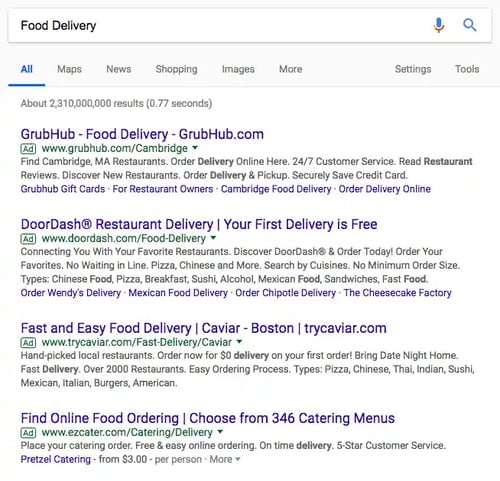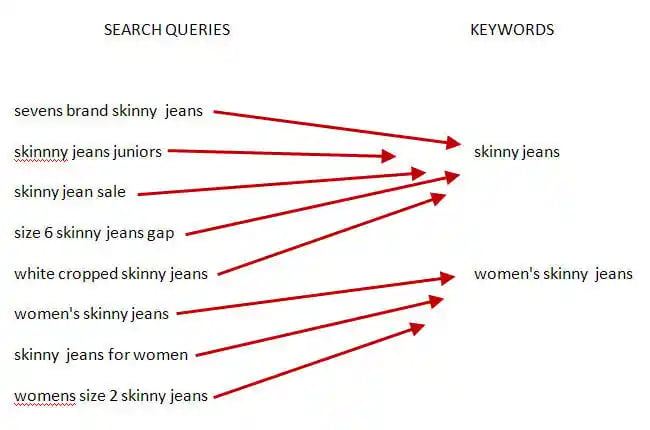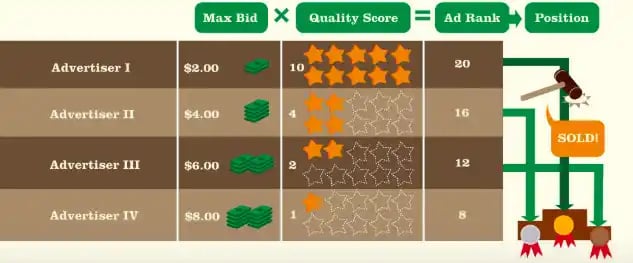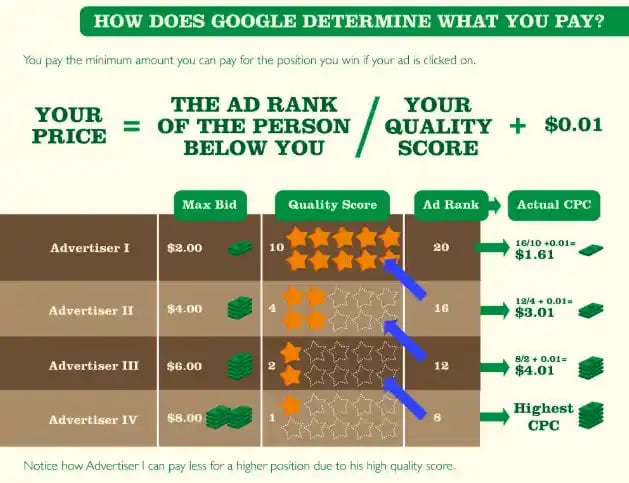When it comes to generating traffic and brand awareness, digital advertising is the way to go. It's surpassing traditional advertising, and Google is a huge reason why. As one of the biggest digital advertising platforms, Google is responsible for 37.2% of total U.S. digital ad spending alone.
But how can you take advantage of the advertising opportunities on Google? By knowing how each of its programs — Google Ads and Google AdSense — work and evaluating which is right for you (or both).
In this article, we'll cover:
What Is Google Ads?
Google Ads — formerly known as Google AdWords — allows advertisers to make bids for ad placements to drive traffic to their websites. These placements can be in Google's Search Engine Results Pages (SERPs) or the Google Display Network (the network of sites, apps, and more that show Google display ads).
Search
The search ads that appear in the SERPs are a great option if you know there's a demand for your product and your audience is using search engines to satisfy it.

Display
The Google Display Network ads — also known as banner or display ads — are more visual, perfect for grabbing attention as you "rent" space where your audience hangs out online.

Google actually has another advertising program that they released three years after Google Ads ’ inception. It’s called Google AdSense.
What Is Google AdSense?
Google AdSense allows publishers to place ads on their websites and other "real estate" in exchange for a "commission." These publishers make up a portion of the Google Display Network that advertisers can leverage through Google Ads.
In the image below, the recipe website uses Google AdSense to allow 2 advertisers to place banner ads on their site. The recipe site is paid by Google for the success of these ads. (More on this later.)
Google AdSense is perfect for website publishers who are already getting traffic and want to monetize it.
Read on as we go over the main differences between Google Ads and AdSense, for whom they’re geared toward, and what their cost structure is like.
Ads (Formerly AdWords) vs. AdSense
While the Google Ads program is geared toward attracting advertisers, the Google AdSense program is geared toward attracting publishers. Advertisers use Google Ads to drive traffic to their sites, and publishers use Google AdSense to monetize their existing traffic.
Below, we've highlighted some core differences between the Google advertising options so you can make decisions on how best to distribute your ads budget.
Purpose
| Platform | Purpose |
| Google Ads (Search) | Generate traffic to your own site from Google as a search engine. |
| Google Ads (Display) | Generate traffic to your own site from the Google Display Network of publishing partners, mobile apps, and video. |
| Google AdSense | Generate traffic for other sites as a Google Display Network publishing partner. |
Strategy
| Platform | Strategy |
| Google Ads (Search) | You know that your audience searches for your products or services on Google, and you want to show up in the SERPs for those queries. |
| Google Ads (Display) | Your audience may not know about your product or service and aren't searching for it on Google. However, a visual ad may catch their eye if you can show up on the sites where they do hang out. |
| Google AdSense | Your site is generating traffic, and you want to monetize it. You don't mind "renting out" real estate on your site to advertisers that your audience may find interesting. |
Cost Structure
| Platform | Cost Structure |
| Google Ads (Search) | You pay a fee every time a user clicks on one of your ads. This cost per click (CPC) can vary based on how much you bid, your ad rank compared to the competition, and your quality score. For this reason, more competitive keywords can have a higher CPC. |
| Google Ads (Display) | You can choose the right pricing for your goals: Paying by cost-per-click (CPC), cost-per-thousand impressions (CPM), or cost-per-action (CPA). CPC is better for generating traffic, CPM is better for generating awareness, and CPA is better for conversions. According to Google, you bid for placement, and "the winner of the auction pays the minimum amount necessary to outrank the next advertiser in the auction." Competition drives up bidding, so industry and highly sought-after publications may cost more. |
| Google AdSense | Participation in AdSense is free, and you receive commission for the clicks, impressions, and other interactions the ads on your site receive from users. For this reason, your audience, the ad placement, and the ad quality will all be factors in how much you can make with AdSense. |
As you can see from the table above, cost structure depends on a number of variables. We'll go more in-depth on it below, starting with Google Ads.
Google Ads (Search)
Naturally, there’s enormous demand for the top ad rankings, so Google triggers an auction anytime there are at least two advertisers bidding for keywords that are related to search queries that users consistently enter into Google.

Advertisers can then categorize keywords and their corresponding ad copy and web page into groups, pick the group they want to bid on, and choose their maximum bid. Next, Google will select a keyword from the advertiser’s ad group that they deem most relevant to users’ search queries and enter it into the auction.
A Google auction isn’t like your typical auction for antiques, though. They want to level the playing field when it comes to leveraging the size of their reach, so instead of the highest bidder always winning the auction, the bidder with the highest Ad Rank always wins.
AdRank is calculated by multiplying your maximum cost-per-click bid with the quality score of your ad, which is calculated by measuring your page’s relevance to the keyword, user experience, and click-through-rate. This means organizations can’t acquire the top ranking for any keyword they want just because they have the biggest ad budgets. Their content has to be engaging.

Google Ads wants to incentivize the best advertisers to advertise the best content on their search engine results pages, so they reward ads that have high quality scores with higher ad rankings and lower cost-per-clicks.
In the same vein, they also want to discourage bad advertisers from advertising bad content, so advertisers with low quality scores will usually only acquire a high ad position if they pay a huge cost-per-click bid. If they want to pay lower a cost-per-click, they have to settle with stooping at the bottom of the ad rankings.
If you win a Google auction, your actual cost-per-click is calculated by the second highest ad rank divided by your quality score, plus one cent. The only time you’ll pay your maximum bid is if you’re the only bidder in the auction or if you make the highest bid in the auction, but you have the lowest ad rank. In this case, you’ll acquire the last ad rank.

Google Ads (Display) / Google AdSense
For display ads, just as with search ads, advertisers bid on publishers’ ad space in the Google Ads auction. They bid on certain keywords, and if a publisher's content has the same or similar keywords, Google will sell their ad space to the highest bidder and pay the publisher a small portion of the bid whenever people click the ad on their website.
However, AdSense doesn’t optimize the ads that they display on publishers’ website for a maximum return on investment like Google Ads does for its search advertisers when they want to optimize their ad campaigns. So, essentially, the amount of money a publisher can earn with AdSense hinges on how well they place the ads on their site and how well advertisers can craft their ads.
Publishers do have control over the types of ads that are displayed, though. They can choose from text ads, display ads, rich media ads, and more. They can also customize their ad’s style or create their own, which gives them the ability to change the size, color, textual, background, and border details of the ads that display on their website. Additionally, they can only place three content ads, three link ads, and two search boxes on each of their web pages.
Google Ads (both Search and Display) and Google AdSense are effective ways to generate revenue with digital advertising methods — the former as you drive traffic to your site and the latter as you use your site to drive traffic elsewhere.
Once you choose the program(s) that are right for you, you can begin your strategy and execution.
Editor's note: This post was originally published in March 2019 and has been updated for comprehensiveness.













